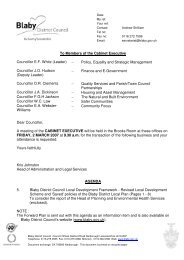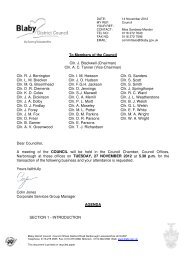Public reports pack PDF 3 MB - Blaby District Council
Public reports pack PDF 3 MB - Blaby District Council
Public reports pack PDF 3 MB - Blaby District Council
You also want an ePaper? Increase the reach of your titles
YUMPU automatically turns print PDFs into web optimized ePapers that Google loves.
2.3 Joint Strategic Needs Assessment (JSNA)<br />
The <strong>Blaby</strong> JSNA is the primary document which describes the health<br />
and wellbeing needs in <strong>Blaby</strong> <strong>District</strong>. It tell us that<br />
• In 2010 the population of <strong>Blaby</strong> was estimated to be 128200. Around<br />
42% of the population are aged 60 years and over. By 2030 the<br />
population of over 65’s is estimated to increase by 60%.<br />
• In 2010 there were 54100 people over 60 years and 27500 aged over<br />
80.<br />
• In 2010 there are estimated to be around 7500 people in <strong>Blaby</strong> over<br />
the age of 65 with a limiting long term illness. By 2030 this is estimated<br />
to increase to around 12200, an increase of 63.6%.<br />
• It is estimated that 19, 400 adults are obese, 6.4% of reception<br />
children and 14% of year 6’s.<br />
• 14, 700 adults smoke<br />
• There are an estimated 13700 adults who binge drink (18.2%)<br />
• In 2010 there are estimated 1170 people in <strong>Blaby</strong> with dementia. By<br />
2030 this is estimated to increase to 2280 people, an increase of 96%.<br />
• In 2010/11 there were 499 people in <strong>Blaby</strong> registered with their GP as<br />
having a mental health disorder including schizophrenia, biopolar<br />
disorder and other psychoses.<br />
This evidences a greater need for mental health support services.<br />
The facts and figures inform us that in the longer term an ageing<br />
population will mean there will be a rise in demand for health services<br />
and long term care, creating a challenge for the funding of public<br />
services. We will also need to provide more choice in homes for the<br />
elderly. Current supported (sheltered) stock is out of date and fails to<br />
meet decent homes standard. We need to work towards improving the<br />
choice for the elderly.<br />
Alongside this there are those individuals within the district whose<br />
unhealthy lifestyles have a significant impact on people’s quality of life<br />
and ability for people to maintain independence. They also have a<br />
significant impact on the demand for health and social care services.<br />
These choices and behaviours include alcohol, substance use,<br />
smoking and healthy weight.<br />
Section 3 Identifying vulnerability<br />
3.1. The key element is that we identify a vulnerable person at the earliest<br />
possible stage. Identification can be difficult as vulnerable people often<br />
demonstrate quite rational and normal behaviour with the<br />
characteristics being fragmented, obscure and particular to individuals.<br />
Identification of a vulnerable person can occur at any time during the<br />
course of an individuals’ contact with us and staff should ensure that<br />
they use any contact as a way by which potential vulnerability can be<br />
identified.<br />
Page 228




